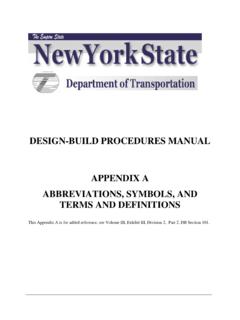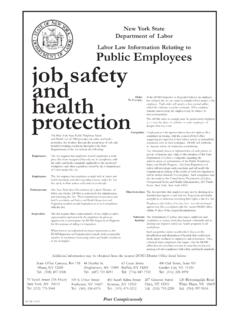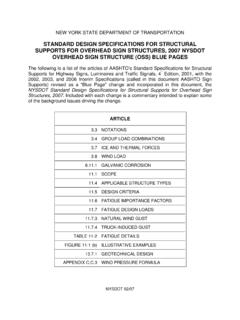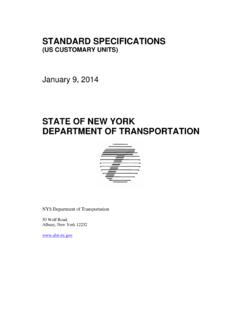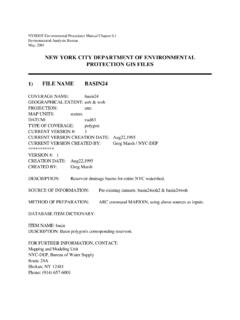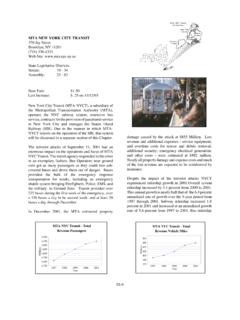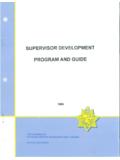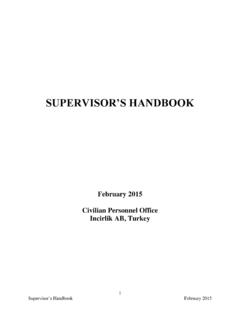Transcription of BASIC SUPERVISION - NYSDOT Home
1 BASIC . SUPERVISION . Study Guide Effective January 2005. New York State Department of Transportation Transportation Maintenance Division 2. This book contains material adapted from many sources including: Supervising New York State: Introductory Program Developed by the New York State Governor's Office of Employee Relations, Cornell University, Extension Division of the NYS School of Industrial and Labor Relations, and The Civil Service Employees Association, Inc.: 1985. 3. TABLE OF CONTENTS: Introduction .. 5. Definitions of 7. 13. Leadership .. 21. Decision Making .. 29. Working With 43.
2 Communication .. 53. 59. Developing Employee 73. Performance Evaluation .. 83. Managing Diversity .. 87. Procedures: SDR & Accident Reporting .. 93. Internal 103. Policy Reference Material: Safety, OTETA, EAP, Positive 107. Motivation .. 123. 131. supervisor 's Resource Listing .. 133. 4. blank 5. INTRODUCTION. The mission of the Department of Transportation (DOT) is to ensure safe, efficient, balanced and environmentally sound transportation to everyone who works and travels in New York State. As an organization, our values are: Excellence, People, Teamwork, Pride and Integrity. To accomplish this mission and support these values, DOT relies on the leadership skills of its supervisors.
3 Good first-line SUPERVISION is vital to the efficiency and productivity of our work. It is also the most important factor in the quality of working life of every employee. DOT is therefore committed to providing training for all new supervisors. 6. OBJECTIVE: The objective of this training is to help new first-line supervisors develop the skills needed to handle the core tasks of SUPERVISION . The core tasks are: - Delegation: Trusting another person to do a job for which you remain responsible - Leadership: The ability to influence the actions of others - Decision Making: Choosing actions from available alternatives to achieve results - Team Building: Helping groups achieve common goals through interaction and unity - Communication: The transmission of a message between a sender and a receiver - Counseling: Correcting unacceptable employee behavior - Evaluating Performance: Letting people know where they stand - Managing Diversity.
4 Accepting, incorporating and empowering diverse human talent - Risk Management: Finding, reporting, and controlling risks - Motivation: Providing incentives for action New supervisors face a challenge when they first take on responsibility for the work of others. They find themselves playing new roles and adjusting to new relationships. A. study of the core tasks of SUPERVISION will help new supervisors make this personal adjustment. 7. Definitions of SUPERVISION Performance Supervisors will be able to Objective: explain the full range of responsibilities involved in supervising others.
5 Learning Supervisors will recognize the Objective: various aspects of the job of SUPERVISION and will understand how their job fits into their organization. 8. Definition of SUPERVISION : SUPERVISION is getting the job done through others.. This classic definition of SUPERVISION states the relationship between supervisors, subordinates, and work. However, it doesn't explain how to be a delegator, a decision maker, a coach, an instructor, a motivator, or most importantly, a leader. The skills of good SUPERVISION are new to most people when they are asked to lead for the first time. To be successful as a leader, the new supervisor needs to consider three broad areas: ADMINISTRATIVE: The new supervisor is accountable for many organizational procedures that subordinates don't have to consider.
6 These include daily reports, monitoring time and attendance, budgeting, work orders, transmitting management directives and bulletins, and a host of other types of information. TECHNICAL: New supervisors have demonstrated their proficiency in technical skills in order to be promoted to SUPERVISION . However, as a leader becomes more involved in SUPERVISION , the amount of time available for doing technical tasks decreases and the amount of time spent helping others increases. Supervisors eventually find themselves helping people with tasks that they themselves have never done. INTERPERSONAL: Becoming an effective supervisor involves learning a whole set of leadership skills .
7 Prior training both on the job and in school probably hasn't covered the interpersonal skills of leadership. New supervisors need to look to role models and mentors for tips on leadership behaviors. They also need to examine their own personal styles and consider the changes they need to make for their own growth and development. As an exercise in defining SUPERVISION , think about all the different tasks that are part of the supervisor 's job. Make a list of these tasks on the next page and discuss them with your manager. Ask if you will actually be evaluated on how well or poorly you perform each task.
8 9. SUPERVISION Task List: 10. "Supervisors are responsible for planning, organizing, directing, and controlling the activities of employees who do the necessary tasks and services of organizations.". (from Steinmetz & Todd: SUPERVISION , First Line Management, NYS Library call number: C, , S. 823, 93-47647). * Supervisory Duties: Planning and Organizing: Lay out the work and decide how to handle it. Processing the Work: Assign the work and supply what your employees need to get the job done. Controlling the Operation: Keep the work up to standards and check on costs and materials. Administering Rules: See that conduct and procedures are done according to the rules.
9 Keeping People Informed: Talk with and listen to staff - up and down the line. Making Improvements: Find better ways for doing the work and solve job problems. Handling Personnel Matters: Administer leave time, benefits, pay, change of jobs, overtime, and other personnel functions. Training and Development: Break in new people, build morale, plan replacements. Monitoring Safety and Security: Prevent trouble. Deal with accidents and illnesses. Safeguard equipment and supplies. Serving as Representative: Act for the group or the organization as required.". * (From: Howard Shout: Start Supervising, NYS Library call number: C, , S 559, 85-31810).
10 11. The Hawthorne Effect Between the years 1924 and 1930, a branch of AT&T, the Hawthorne Works, conducted a famous experiment in management and SUPERVISION . The resulting principle, the "Hawthorne Effect," established the importance of interpersonal contact in supervisory/subordinate relations. Over a series of years, experimenters at Hawthorne varied the amount of room light in various departments of the plant. They thought that as room light went up, productivity would increase, and that as room light went down, productivity would decrease. To their surprise, the experimenters found that productivity went up whenever they changed the room light, either way.

